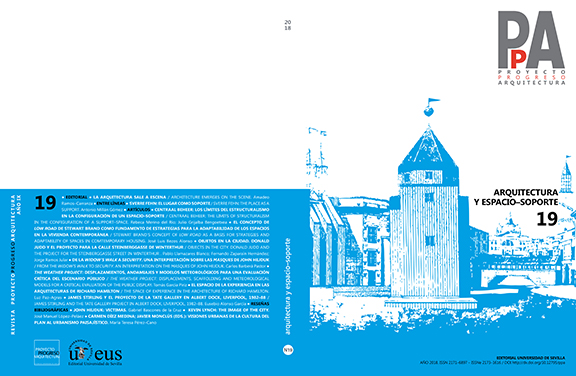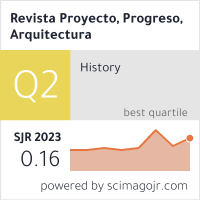CENTRAAL BEHEER: LOS LÍMITES DEL ESTRUCTURALISMO EN LA CONFIGURACIÓN DE UN ESPACIO–SOPORTE / CENTRAAL BEHEER: THE LIMITS OF STRUCTURALISM IN THE CONFIGURATION OF A SUPPORT–SPACE
DOI:
https://doi.org/10.12795/ppa.2018.i19.02Palabras clave:
Centraal Beheer, Herman Hertzberger, ciudad, espacio–soporte, estructuralismo, deriva / city, support–space, structuralism, dériveResumen
RESUMEN En 1968, Herman Hertzberger comienza el proyecto para Centraal Beheer, influido por las tendencias artísticas y culturales de la época. El concepto de espacio–soporte surge en este contexto fuertemente vinculado a la idea de la ciudad tradicional como marco estable capaz de soportar distintas interpretaciones a lo largo del tiempo y catalizador de las relaciones cotidianas entre el ser y el entorno. Centraal Beheer se considera un ejemplo de espacio–soporte, ya que la estrategia de proyecto de reproducción de las condiciones de habitabilidad de la ciudad tradicional persigue una mayor implicación del usuario en la personalización del espacio y se rige por una clara diferenciación de la forma arquitectónica y la sucesión de acontecimientos. Su funcionamiento se evalúa mediante la aplicación de la técnica de la deriva y la psicogeografía, concebidas inicialmente por la Internacional Situacionista para redescubrir el entorno urbano como un espacio–soporte, en las que el factor tiempo y el papel protagonista de las personas son también determinantes. El artículo busca demostrar cómo el bagaje estructuralista de Herman Hertzberger permite entender la réplica urbana de Centraal Beheer como un espacio–soporte desde una perspectiva antropológica y epistemológica. Por medio de una colección de textos, fotografías y croquis, la hipótesis se demuestra en un estudio de naturaleza transversal que se nutre de investigaciones coetáneas desarrolladas en campos como la arquitectura, el arte, la lingüística o la sociología.
SUMMARY In 1968, Herman Hertzberger starts the project for Centraal Beheer inspired by the artistic and cultural trends in the sixties. It is in this context that the support–space concept, strongly linked to the idea of the traditional city, arises as a framework able to bear diverse interpretations throughout time and catalyst for the everyday relationships between the individual and the surroundings. Centraal Beheer is considered an example of a support–space building, up to the extent that the project’s strategy of reproducing the traditional city habitability conditions implies a greater user involvement in the space configuration while it is subject to a clear distinction between the architectural form and the sequence of events. Centraal Beheer’s functioning is assessed through the application of the dérive technique and psychogeography, which was initially conceived by Situationist International to rediscover the urban “milieu” as a support–space in which the time factor and the leading role of the user are also determinantal. This article aims to demonstrate how Herman Hertzberger’s structuralist background allows us to understand the urban replica of Centraal Beheer as a support–space from an anthropological and epistemological perspective. It is by means of a collection of texts, pictures, and unpublished sketches, that the hypothesis is demonstrated in a cross–sectional study nourished by coetaneous researches into fields such as architecture, art, linguistics or sociology.
Descargas
Citas
BADCOCK, Christopher Robert; LÉVI–STRAUSS, Claude. The Ecumenical Anthropologist. Solutions to Some Persistent Problems in Theoretical Sociology Found in the Works of Claude Lévi–Strauss. En: The British Journal of Sociology, 1975, vol. 26, n.º 2, pp. 156–168. ISSN 0007–1315. DOI: https://doi.org/10.2307/589586.
BERGEIJK, Herman van. Herman Hertzberger. Basilea–Boston–Berlín: Birkhäuser Verlag, 1997.
CONSTANT. New Babylon. En: Randstad. Driemaandelijks, 1962, n.º 2, pp. 127–138.
CONSTANT. New Babylon. Den Haag: Gemeentemuseum Den Haag, 1974.
COVERLEY, Merlin. Psychogeography. Harpenden: Pocket Essentials, 2010.
DOMINGO CALABUIG, Débora; CASTELLANOS GÓMEZ, Raúl. Urdimbre y trama: el caso de la Universidad Libre de Berlín. En: Proyecto, progreso, arquitectura. Sevilla: Editorial Universidad de Sevilla, 2011, n.º 4, pp. 30–43. ISSN 2171–6897. DOI: http://dx.doi.org/10.12795/ppa.2011.i4.02.
EYCK, Aldo van. Editorial. En: Forum voor Architectuur en Daarmee Verbonden Kunsten, 1963, n.º 3, pp. 97–98. ISSN 0015–8372.
EYCK, Aldo van; LIGTELIJN, Vincent; STRAUVEN, Francis. Aldo van Eyck: Collected Articles and Other Writings 1947–1998. Ámsterdam: SUN, 2008.
GRANÉS, Carlos. El puño invisible. Madrid: Taurus, 2012.
HERTZBERGER, Herman. Editorial. En: Forum voor Architectuur en Daarmee Verbonden Kunsten, 1960–1, n.º 1, pp. 1–2. ISSN 0015–8372.
HERTZBERGER, Herman. Flexibiliteit en Polyvalentie. En: Forum voor Architectuur en Daarmee Verbonden Kunsten, 1962, n.º 3, pp. 115–121. ISSN 0015–8372.
HERTZBERGER, Herman. De Wederkerigheid van Vorm en Programma. En: Forum voor Architectuur en Daarmee Verbonden Kunsten, 1967, n.º 7, p. 16. ISSN 0015–8372.
HERTZBERGER, Herman. Identiteit. En: Forum voor Architectuur en Daarmee Verbonden Kunsten, 1967, n.º 7, pp. 17–18. ISSN 0015–8372.
HEUVEL, Dirk van den, ed.; FRAUSTO, Salomon, ed. Open Structures: An Introductory Dossier on Dutch Structuralism. En: Volume (Amsterdam, Netherlands), 2013, vol. 35, n.º 1, pp. 65–96. ISSN: 1574–9401.
LEFEBVRE, Henri. Critique of Everyday Life Volume I: Introduction. Trad. de John MOORE, pról. de Michel TREBITSCH. Londres–Nueva York: Verso, 1991 [1958].
LEFEBVRE, Henri. Critique of Everyday Life Volume II: Foundations for a Sociology of the Everyday. Trad. de John MOORE, pról. de Michel
TREBITSCH. Londres–Nueva York: Verso, 2002 [1961].
LÉVI–STRAUSS, Claude. Structural Anthropology. Nueva York: Basic Books, 1963.
LÉVI–STRAUSS, Claude. The Scope of Anthropology. En: Current Anthropology, 1966, vol. 7, n.º 2, pp. 112–123. ISSN 0011–3204. DOI: http://dx.doi.org/10.1086/200687.
MAYORAL CAMPA, Esther. Pensamientos compartidos. Aldo van Eyck, el grupo COBRA y el arte. En: Proyecto, progreso, arquitectura. Sevilla: Editorial Universidad de Sevilla, 2014, n.º 11, pp. 64–75. ISSN 2171–6897. DOI: https://doi.org/10.12795/ppa.2014.i11.05.
MERINO DEL RÍO, Rebeca; GRIJALBA BENGOETXEA, Julio; GRIJALBA BENGOETXEA, Alberto. Paisajes urbanos. El edificio como una ciudad. Centraal Beheer. En: ZARCH. Zaragoza: Prensas de la Universidad de Zaragoza, 2016, n.º 7, pp. 148–165. ISSN 2341–0531. DOI: https://doi.org/10.26754/ojs_zarch/zarch.201671522.
MERINO DEL RÍO, Rebeca; GRIJALBA BENGOETXEA, Julio. Sobre la contribución de Herman Hertzberger a la corriente del estructuralismo holandés. En: Constelaciones. Madrid: Fundación Universitaria San Pablo CEU, 2018, n.º 6, pp. 33–47. ISSN 2340–177X.
MULLER, Sheila. Dutch Art: An Encyclopedia. Nueva York–Londres: Routledge, 2011.
RAMOS CARRANZA, Amadeo; AÑÓN ABAJAS, Rosa María. Contracultura, acciones y arquitectura. En: Proyecto, progreso, arquitectura. Sevilla: Editorial Universidad de Sevilla, 2018, n.º 18, pp. 12–15. ISSN 2171–6897. DOI: http://dx.doi.org/10.12795/ppa.2018.i18.11.
RISSELADA, Max; HEUVEL, Dirk van den. Team 10: 1953–1981, In Search of a Utopia of the Present. Rotterdam: NAi, 2005.
RODRÍGUEZ PRADA, Víctor. La generación del estructuralismo holandés a través de sus maquetas. El caso de Herman Hertzberger. 1958–1968. En: Proyecto, progreso, arquitectura. Sevilla: Editorial Universidad de Sevilla, 2016, n.º 15, pp. 100–111. ISSN 2171–6897. DOI: https://doi.org/10.12795/ppa.2016.i15.07.
RYKWERT, Joseph. The Idea of a Town. En: Forum voor Architectuur en Daarmee Verbonden Kunsten, 1963, n.º 3, pp. 99–148. ISSN 0015–8372.
SARTRE, Jean–Paul. Critique of Dialectical Reason, Volume I: Theory of Practical Ensembles. Londres–Nueva York: Verso, 2004 [1960].
SENNETT, Richard. The Uses of Disorder: Personal Identity and City Life. Nueva York: Knopf, 1970.
TEERDS, Hans; HABRAKEN, John; HAVIK, Klaske. Define and Let Go. An Interview with John Habraken. Productive Uncertainty. En: OASE, 2011, n.º 85, pp. 8–16. ISSN 0169–6238.
WARK, Mckenzie. The Beach beneath the Street: The Everyday Life and Glorious Times of the Situationist Internacional. Londres–Nueva York: Verso, 2011.
Descargas
Publicado
Cómo citar
Número
Sección
Licencia
Las ediciones impresa y electrónica de esta Revista son editadas por el Secretariado de Publicaciones de la Universidad de Sevilla, siendo necesario citar la procedencia en cualquier reproducción parcial o total.
Salvo indicación contraria, todos los contenidos de la edición electrónica se distribuyen bajo una licencia de uso y distribución “Creative Commons Atribución-NoComercial-SinDerivar 4.0 Internacional” ![]() . Puede consultar desde aquí la versión informativa y el texto legal de la licencia. Esta circunstancia ha de hacerse constar expresamente de esta forma cuando sea necesario.
. Puede consultar desde aquí la versión informativa y el texto legal de la licencia. Esta circunstancia ha de hacerse constar expresamente de esta forma cuando sea necesario.
Los autores/as que publiquen en esta revista aceptan las siguientes condiciones:
- Los autores/as conservan los derechos de autor y ceden a la revista el derecho de la primera publicación, con el trabajo registrado con la licencia de atribución de Creative Commons, que permite a terceros utilizar lo publicado siempre que mencionen la autoría del trabajo y a la primera publicación en esta revista.
- Los autores/as pueden realizar otros acuerdos contractuales independientes y adicionales para la distribución no exclusiva de la versión del artículo publicado en esta revista (p. ej., incluirlo en un repositorio institucional o publicarlo en un libro) siempre que indiquen claramente que el trabajo se publicó por primera vez en esta revista.
- Se permite y recomienda a los autores/as a publicar su trabajo en Internet (por ejemplo en páginas institucionales o personales) antes y durante el proceso de revisión y publicación, ya que puede conducir a intercambios productivos y a una mayor y más rápida difusión del trabajo publicado (vea The Effect of Open Access).









